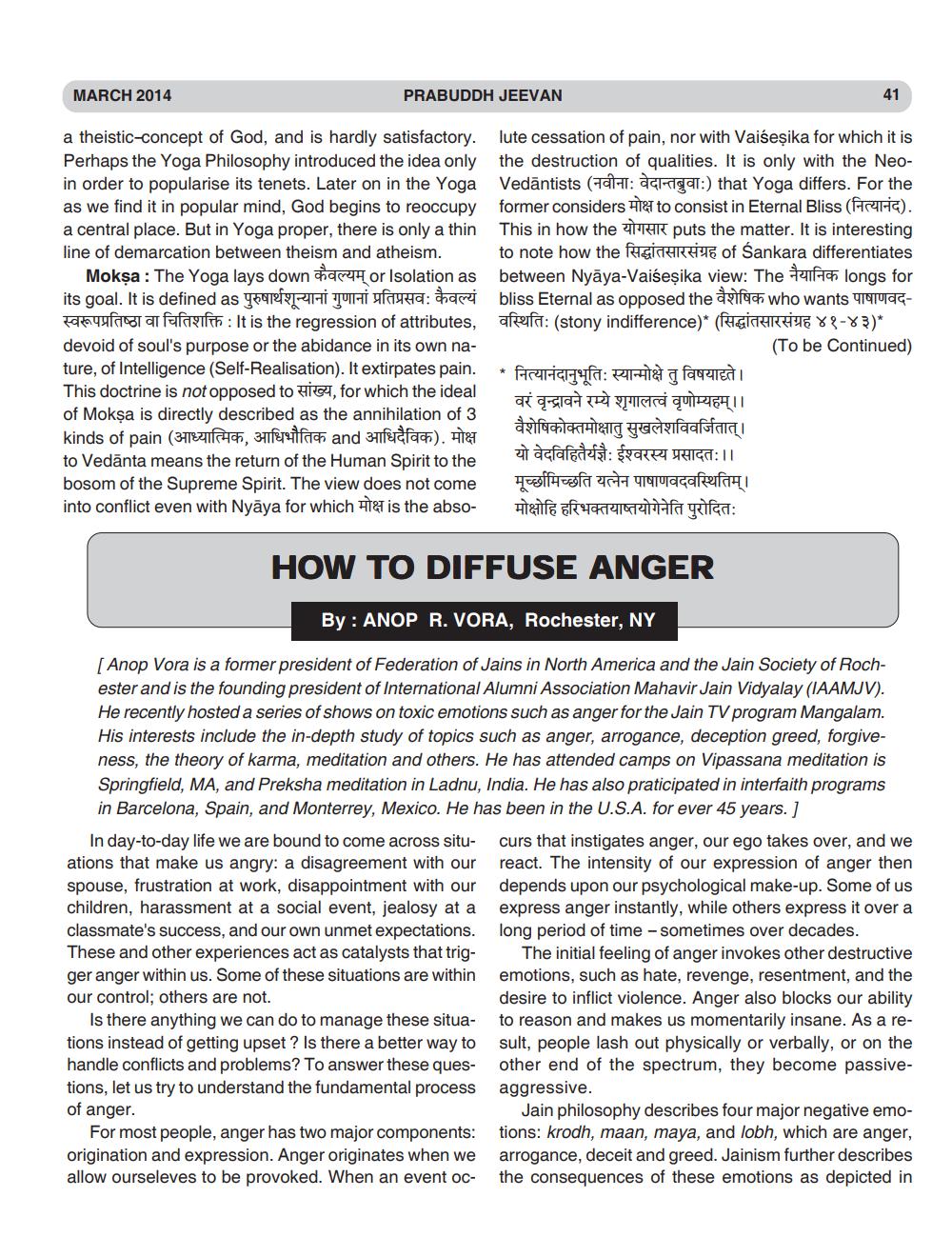________________
MARCH 2014
PRABUDDH JEEVAN
41
a theistic-concept of God, and is hardly satisfactory. lute cessation of pain, nor with Vaiseșika for which it is Perhaps the Yoga Philosophy introduced the idea only the destruction of qualities. It is only with the Neoin order to popularise its tenets. Later on in the Yoga Vedāntists (701: aggar:) that Yoga differs. For the as we find it in popular mind, God begins to reoccupy former considers 14 to consist in Eternal Bliss (CHC). a central place. But in Yoga proper, there is only a thin This in how the puts the matter. It is interesting line of demarcation between theism and atheism. to note how the fuGiAERE of Sankara differentiates
Moksa : The Yoga lays down ddy or Isolation as between Nyāya-Vaiseșika view: The fich longs for its goal. It is defined as पुरुषार्थशून्यानां गुणानां प्रतिप्रसव: कैवल्यं bliss Eternal as opposed the वैशेषिक who wants पाषाणवद
fast at fafatgifen: It is the regression of attributes, afera: (stony indifference)* (FHGGAR:146 -83)* devoid of soul's purpose or the abidance in its own na
(To be Continued) ture, of Intelligence (Self-Realisation). It extirpates pain.
* HIHIHHfC: VI-Tà q fa4echI This doctrine is not opposed to 164, for which the ideal
वरं वृन्द्रावने रम्ये शृगालत्वं वृणोम्यहम्।। of Moksa is directly described as the annihilation of 3 kinds of pain (3178 , 34fereitfach and eradi). Ha
वैशेषिकोक्तमोक्षातु सुखलेशविवर्जितात्। to Vedānta means the return of the Human Spirit to the
यो वेदविहितैर्यज्ञैः ईश्वरस्य प्रसादतः।। bosom of the Supreme Spirit. The view does not come
मूर्छामिच्छति यत्नेन पाषाणवदवस्थितिम्। into conflict even with Nyaya for which मोक्ष is the abso- मोक्षोहि हरिभक्तयाष्तयोगेनेति पुरोदितः
HOW TO DIFFUSE ANGER
By : ANOP R. VORA, Rochester, NY
Anop Vora is a former president of Federation of Jains in North America and the Jain Society of Rochester and is the founding president of International Alumni Association Mahavir Jain Vidyalay (IAAMJV). He recently hosted a series of shows on toxic emotions such as anger for the Jain TV program Mangalam. His interests include the in-depth study of topics such as anger, arrogance, deception greed, forgiveness, the theory of karma, meditation and others. He has attended camps on Vipassana meditation is Springfield, MA, and Preksha meditation in Ladnu, India. He has also praticipated in interfaith programs in Barcelona, Spain, and Monterrey, Mexico. He has been in the U.S.A. for ever 45 years. ]
In day-to-day life we are bound to come across situ- curs that instigates anger, our ego takes over, and we ations that make us angry: a disagreement with our react. The intensity of our expression of anger then spouse, frustration at work, disappointment with our depends upon our psychological make-up. Some of us children, harassment at a social event, jealosy at a express anger instantly, while others express it over a classmate's success, and our own unmet expectations. long period of time-sometimes over decades. These and other experiences act as catalysts that trig- The initial feeling of anger invokes other destructive ger anger within us. Some of these situations are within emotions, such as hate, revenge, resentment, and the our control; others are not.
desire to inflict violence. Anger also blocks our ability Is there anything we can do to manage these situa- to reason and makes us momentarily insane. As a retions instead of getting upset? Is there a better way to sult, people lash out physically or verbally, or on the handle conflicts and problems? To answer these ques- other end of the spectrum, they become passivetions, let us try to understand the fundamental process aggressive. of anger.
Jain philosophy describes four major negative emoFor most people, anger has two major components: tions: krodh, maan, maya, and lobh, which are anger, origination and expression. Anger originates when we arrogance, deceit and greed. Jainism further describes allow ourseleves to be provoked. When an event oc- the consequences of these emotions as depicted in




